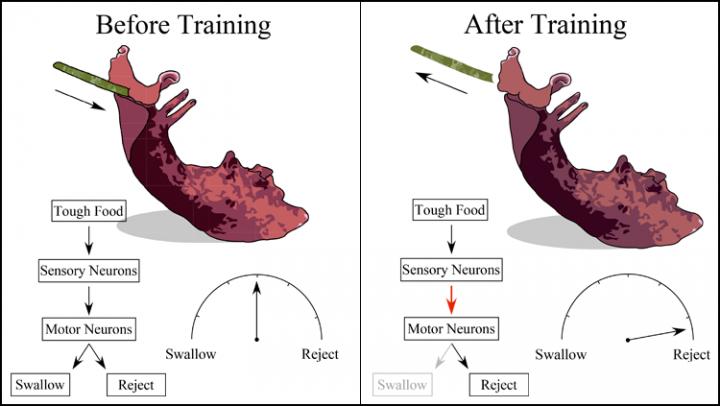Scientists pin down how learning influences behavior through widespread synaptic changes

Credit: Tam et al., JNeurosci 2020
Learning changes behavior by altering many connections between brain cells in a variety of ways all at the same time, according to a study of sea slugs recently published in JNeurosci. The findings offer insight into how human learning can impact widespread brain areas.
Learning influences behavior by changing the synapses, the connections between neurons. Although simple, those changes prove considerable and occur in concert in new research by Tam et al.
The researchers explored how the synapses in the sea slug Aplysia change after the animals learn to reject swallowing inedible food. The result was a widespread change in the feeding system, as the animals now rejected non-food objects as well. In Aplysia, touch-sensing neurons form synapses with neurons that control groups of muscles responsible for feeding. After learning to reject food, synapses in this network of neurons underwent a variety of changes, both in number and amplitude. Some synapses strengthened, others weakened, and some switched between excitatory and inhibitory. All these changes combined to increase the likelihood that the feeding muscles would now reject an object that they might previously have tried to swallow.
Manuscript title: Multiple Local Synaptic Modifications at Specific Sensorimotor Connections After Learning Are Associated With Behavioral Adaptations That Are Components of a Global Response Change
Please contact [email protected] for full-text PDF and to join SfN’s journals media list.
###
About JNeurosci
JNeurosci, the Society for Neuroscience’s first journal, was launched in 1981 as a means to communicate the findings of the highest quality neuroscience research to the growing field. Today, the journal remains committed to publishing cutting-edge neuroscience that will have an immediate and lasting scientific impact, while responding to authors’ changing publishing needs, representing breadth of the field and diversity in authorship.
About The Society for Neuroscience
The Society for Neuroscience is the world’s largest organization of scientists and physicians devoted to understanding the brain and nervous system. The nonprofit organization, founded in 1969, now has nearly 37,000 members in more than 90 countries and over 130 chapters worldwide.
Media Contact
Calli McMurray
[email protected]
Related Journal Article
http://dx.




